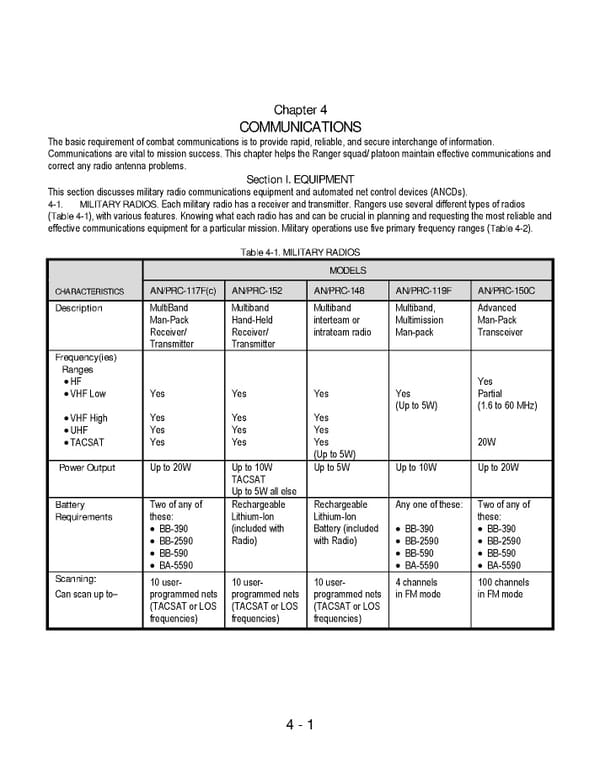4 - 1 Chapter 4 COMMUNICATIONS The basic requirement of combat communications is to provide rapid, reliable, and secure interchange of information. Communications are vital to mission success. This chapter helps the Ranger squad/ platoon maintain effective communications and correct any radio antenna problems. Section I. EQUIPMENT This section discusses military radio communications equipment and automated net control devices (ANCDs). 4-1. MILITARY RADIOS. Each military radio has a receiver and transmitter. Rangers use several different types of radios (Table 4-1), with various features. Knowing what each radio has and can be crucial in planning and requesting the most reliable and effective communications equipment for a particular mission. Military operations use five primary frequency ranges (Table 4-2). Table 4-1. MILITARY RADIOS MODELS CHARACTERISTICS AN/PRC-117F(c) AN/PRC-152 AN/PRC-148 AN/PRC-119F AN/PRC-150C Description MultiBand Man-Pack Receiver/ Transmitter Multiband Hand-Held Receiver/ Transmitter Multiband interteam or intrateam radio Multiband, Multimission Man-pack Advanced Man-Pack Transceiver Frequency(ies) Ranges •HF Yes • VHF Low Yes Yes Yes Yes (Up to 5W) Partial (1.6 to 60 MHz) •VHF High Yes Yes Yes •UHF Yes Yes Yes • TACSAT Yes Yes Yes (Up to 5W) 20W Power Output Up to 20W Up to 10W TACSAT Up to 5W all else Up to 5W Up to 10W Up to 20W Battery Requirements Two of any of these: • BB-390 • BB-2590 • BB-590 • BA-5590 Rechargeable Lithium-Ion (included with Radio) Rechargeable Lithium-Ion Battery (included with Radio) Any one of these: • BB-390 • BB-2590 • BB-590 • BA-5590 Two of any of these: • BB-390 • BB-2590 • BB-590 • BA-5590 Scanning: Can scan up to– 10 user- programmed nets (TACSAT or LOS frequencies) 10 user- programmed nets (TACSAT or LOS frequencies) 10 user- programmed nets (TACSAT or LOS frequencies) 4 channels in FM mode 100 channels in FM mode
 Ranger Handbook Page 68 Page 70
Ranger Handbook Page 68 Page 70